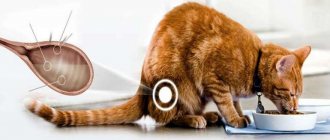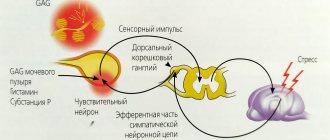The genitourinary system is represented by the kidneys, bladder, urinary canals, prostate gland (males), ovaries (females), uterus and genitals.
The most common diseases of the genitourinary system of dogs include inflammatory diseases caused by bacterial or fungal infections. The creation of suitable conditions for the development of pathogenic microflora can be caused by factors such as hypothermia, stress, sudden changes in living conditions and nutrition.
Features of such diseases include the need to visit a veterinary clinic to make an accurate diagnosis and prescribe individual treatment. Self-medication in this situation can lead to serious complications. We suggest that you familiarize yourself with the main symptoms of this group of diseases in order to detect the problem in time and seek qualified help.
Kidney diseases (nephritis, pyelonephritis, glomerulonephritis)
In dogs, kidney inflammation is recorded more often than in other animals. This is most often associated with improper feeding. A dog is a carnivore and must receive sufficient meat. If the animal is fed plant foods, cereals and vegetables, the urine will be alkaline. Whereas with proper feeding it is sour. Microbes cannot survive in an acidic environment, but in an alkaline environment they begin to thrive and multiply. This is where inflammation occurs.
In addition, the causes of kidney disease can be chemical and physical effects on the organs, infections from the urinary tract, hypothermia, exposure to allergens or other pathological processes.
Signs of kidney disease:
- painful sensations when urinating;
- pain in the lumbar spine or abdomen;
- frequent urination;
- bloody urine;
- swelling;
- arching of the back;
- convulsions;
- smell of urine from the mouth.
Depending on the causes and diagnosis, treatment can be carried out with antibiotics, corticosteroids, antispasmodics, diuretics, and novocaine blockade. Along with this, a special medicated dog food or a special diet is prescribed.
It is necessary to provide your pet with a warm, dry place without drafts and clean water at room temperature.
For the purpose of prevention, it is necessary to keep animals in a warm and dry room, without drafts, avoid hypothermia and feed them properly.
Prevention of urolithiasis in dogs
Prevention of urolithiasis in dogs, first of all, consists of proper care. If your pet has already had urolithiasis, strictly follow the instructions and prescriptions issued by your veterinarian.
If the animal is healthy, remember a few simple rules that will reduce the likelihood of urolithiasis to a minimum:
- feed your dog correctly: either only dry food, which is selected specifically for your pet, or only natural food. Remember: you cannot mix dry and natural food. Even in small quantities! And, most importantly, the dog’s food should include all the necessary minerals and beneficial elements;
- Eliminate raw tap water from your dog's diet. Give your pet either boiled or filtered. And make sure that there is always water in the bowl, especially in the warm season. In summer it is also worth taking a drink with you on walks. Are you thirsty in the heat? Your pet too;
- Walk your dog more often. Spend at least two hours walking a day. Try to get your dog to go outside at least once a day.
- Run, play, watch the physical development of your tailed friend! Do not let your dog lie in one place for days;
- Provide your pet with its own place. Lying on a cold floor is harmful. This also leads to the formation of ICD;
- Get tested at a veterinary clinic at least once a year. Especially if the animal is at risk. Remember: the earlier you detect the disease, the easier your dog will tolerate treatment. The pet will not be in excruciating pain, surgery will be avoided, and the family budget will remain much safer. Yes, prevention is always better than treatment for an advanced disease!
Bladder diseases (cystitis, spasms)
A spasm is a strong contraction of smooth muscle, in this case the bladder. The muscles contract and cannot relax, resulting in severe pain. Bladder spasms occur due to urolithiasis or cystitis. The dog is worried, the bladder is tense and full. In this case, urine is excreted poorly or completely absent. This condition is relieved with antispasmodics. They are administered either intramuscularly or directly into the bladder using a catheter.
Cystitis is inflammation of the mucous membrane of the bladder. Occurs when an infection occurs. Since the bladder is quite resistant to bacteria, a certain provoking factor is needed for the disease to occur. For example, impaired urination, blood circulation, weakened immunity due to hypothermia, etc.
Main symptoms:
- urine with blood;
- frequent urination with pain;
- frequent false urges;
- heat;
- admixture of mucus and pus in the urine.
Treatment for this disease is carried out with antibiotics and sulfonamides.
For prevention purposes, the dog must be kept in a dry room, avoiding drafts and hypothermia. Also, to prevent the formation of stones, you need to follow a proper diet.
Diagnosis of the disease
Do you suspect that your dog is sick? We strongly do not recommend self-medication! The best solution is to seek help from a veterinarian. Only a veterinarian can diagnose urolithiasis and prescribe effective treatment that does not threaten the health and life of your pet.
Methods for diagnosing ICD:
- collecting urine for analysis,
- Ultrasound of the urogenital area,
- X-ray examination.
The veterinarian not only diagnoses the disease, but also determines the location of the stones. They can be located in the kidneys (and postrenal renal failure often develops), ureters, bladder or urethra.
Balanoposthitis
Balanoposthitis is inflammation of the prepuce and glans penis at the same time. It is characterized by pain and redness, discharge of pus, and less often blood. Occurs when urine and sperm accumulate in the preputial sac. The development of the disease is also possible if phimosis is present - narrowing of the foreskin and, as a consequence of the accumulation of secretions, also leading to inflammation.
Treatment boils down to washing the prepuce with potassium permanganate (a weak solution) or chlorhexidine. Then the introduction of syntomycin ointment or levomekol. In severe cases, antibiotics are prescribed. Treatment lasts 2-3 weeks.
Prevention - regular examination by a veterinarian, preventive washing of the prepuce.
Urolithiasis disease
Urolithiasis is the formation of stones or sand in the kidneys or bladder, which prevents the normal flow of urine.
Common reasons for the formation of sand and stones include improper feeding - namely, the predominance of proteins over carbohydrates, excess fish, and dairy products. In addition, urolithiasis can be caused by a genitourinary tract infection. It is also known that some dog breeds may be prone to this disease. This is associated with a genetic disorder of phosphorus-calcium metabolism.
The pathology is characterized by the accumulation of calculi or stones in the bladder and renal pelvis. Essentially, stones are calcium or phosphorus salts that accumulate and prevent urine from being excreted normally. If too many of them form, blockage of the urinary ducts can occur. Without urgent surgical treatment, this condition can lead to the death of the animal.
The disease manifests itself symptomatically:
- pain when urinating;
- lethargy;
- refusal to eat;
- frequent or difficult urination.
The dog should be taken to the veterinarian as soon as possible. He will prescribe antispasmodics, special nutrition that excludes large amounts of calcium and phosphorus salts. Diet is an important component of therapy.
For prevention, you need to create the correct diet for feeding your dog, taking into account the characteristics of the breed. It is also necessary to prevent infections of the genitourinary system.
Prognosis for urolithiasis in dogs
In most cases, urolithiasis in dogs is not treated, but stopped. This should be remembered first of all by owners who have seen the effect of treatment. No, nothing is over! Very often, people who notice that their pet is feeling better stop following the diet and taking medications. Don’t even think about doing this: refusing treatment will return all the symptoms and excruciating pain to your dog in a matter of weeks!
In general, the prognosis is favorable. But only with strict adherence to the instructions, otherwise a relapse cannot be avoided. Follow a diet, walk more, take medications strictly according to instructions and periodically get tested at a veterinary clinic, then the life of your beloved dog will be long, happy, and illnesses will pass and be forgotten!
Orchitis
Inflammation of the testes, or orchitis, most often occurs due to injury, bites and frostbite. It is possible to transfer infection from the urinary tract through the spermatic cords.
The dog experiences pain, the testes become red, hot, and hard to the touch. The dog moves with difficulty, spreading its hind legs and tucking its stomach. With purulent orchitis, the formation of multiple abscesses is possible. If the process is started, the testicle may atrophy (shrink and lose its functions), in which case only castration is indicated.
For treatment, the veterinarian usually prescribes antibiotics and oral sulfonamides. Ointments containing antibiotics are used externally. Novocaine is used to relieve pain, and antihistamines and corticosteroids are used to relieve swelling.
For prevention, you need to try to avoid injuries to the testicles and treat all genitourinary infections in a timely manner.
Prostate diseases
Males of all ages often suffer from prostatitis. This is an inflammation of the prostate gland, in which it enlarges and thereby interferes with urination and bowel movements.
Pathology most often occurs after an untreated infectious disease. Stress, hypothermia, and urolithiasis are also provoking factors. At the same time, prostatitis occurs much less frequently in castrated males. The main cause of the disease is considered to be an imbalance of hormones.
Symptoms. The dog hunches over, whines when its belly is touched, and experiences a frequent urge to urinate. In addition to impaired urination, defecation is also difficult, since the enlarged gland puts pressure on the rectum.
Treatment is limited to antibiotic therapy.
In addition to prostatitis, there are other diseases of the prostate gland: prostatic hyperplasia, cysts, adenoma and abscesses. Since all these pathologies are difficult to treat conservatively and surgically, they are considered severe. Special attention is paid to prevention.
The most predisposed breed is the German Shepherd and its mixed breeds. Other breeds get sick much less frequently.
For the purpose of prevention, you need to protect your dog from hypothermia and treat urinary tract infections in a timely manner. Since the chronic course of prostatitis is very difficult to treat, it is necessary to treat acute inflammation in a timely manner. It is also recommended to conduct regular prostate examinations as part of annual medical examinations.
Clinical case of treatment of acute urinary retention with urinary tract disease in dogs
A Scottish Terrier dog named Vicky was admitted in emergency condition with acute urinary retention. Based on the results of diagnostic tests and examination by a veterinarian, a diagnosis was made: acute urinary retention due to blockage of the urethra by stones with a diameter of 10 mm. Doctor Andrey Konstantinovich Mamedkuliev decided to prescribe surgical treatment with further cystotomy and removal of stones from the urethra. During the operation, stones were removed and the urethra and bladder were washed.
The treatment and surgery were successful. Now Vicky can empty her bladder freely and not experience any pain.
Vaginitis
Bitches may develop a pathology such as vaginitis. This is an inflammation of the vaginal mucosa. It is caused by fungi or bacteria. The causes of inflammation are mainly considered to be a decrease in the body's resistance and vaginal trauma.
The disease is characterized by increased discharge from the vulva. The dog often licks it. The discharge may be colorless or yellowish.
Treatment is mainly local. These are ointments and antimicrobial liniments, solutions. Washing the vagina with an antiseptic.
Prevention comes down to avoiding injuries, stress, good nutrition and maintenance.










